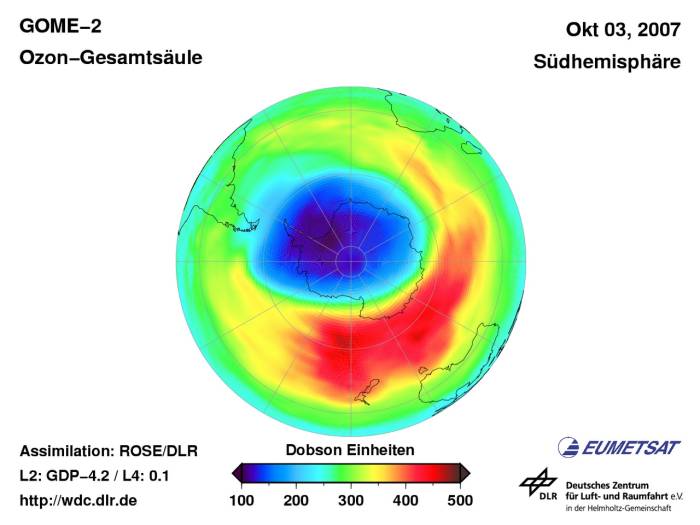Metop-A satellite measures ozone hole
October 5, 2007The “ozone hole” is not shrinking, scientists at the Deutsche Zentrum für Luft- und Raumfahrt (DLR), the German Aerospace Center, have found after analysing data from the Global Ozone Monitoring Experiment 2 (GOME-2) instrument on board EUMETSAT’s Metop-A polar operating satellite, Europe’s new meteorological satellite. The atmospheric data from GOME-2 measurements were derived by the DLR’s Remote Sensing Technology Institute in Oberpfaffenhofen at the request of EUMETSAT. Initial validation of GOME-2 ozone data by ground measurements confirmed the high quality of the satellite data. The DLR’s German Remote Sensing Data Center (DFD) processes GOME-2 ozone data by combining it with models which describe meteorology, physics and atmospheric chemistry, allowing the mapping of the ozone layer and the prediction of ozone distribution. These models can provide additional information, such as the determination of chemical depletion of ozone; up-to-date ozone data and ozone depletion rates are available daily in near real time on the Internet at the World Data Centre for Remote Sensing of the Atmosphere, which is run by the DFD on behalf of the International Council of Scientific Unions. The EUMETSAT Metop-A satellite will collect data for monitoring the ozone in the next 15 years. The main cause of the depletion of the atmosphere’s protective ozone layer is the release of chlorinated fluorocarbons. This depletion, which is most noticeable over the Arctic and Antarctic regions, is of particular environmental concern as the resulting increased levels of ultraviolet radiation can cause serious damage to human health, agriculture, forests and water ecosystems. Current ozone hole over the Antarctic The DLR noted a strong reversal in the spreading of the ozone hole in mid-September because of an unusual meteorological constellation in the south polar stratosphere. An unusually high intensity of planetary waves – which cause air circulation around the world – resulted in the thinning of the ozone layer, especially over the south Atlantic and South America. At the same time, the ozone level rose over Australia and the ozone hole was at its minimum size on 20 September. But this year’s ozone hole over the Antarctic was at its maximum size, twice as big as Europe, at the end of September. The ozone layer had thinned down to 220 Dobson units, a measure of atmospheric ozone, specifically ozone in the stratospheric ozone layer. The global average of the ozone layer is 300 Dobson units. About EUMETSAT The European Organisation for the Exploitation of Meteorological Satellites is an intergovernmental organisation based in Darmstadt, Germany, currently with 20 European Member States (Austria, Belgium, Croatia, Denmark, Finland, France, Germany, Greece, Ireland, Italy, Luxembourg, the Netherlands, Norway, Portugal, Slovakia, Spain, Sweden, Switzerland, Turkey and the United Kingdom) and 10 Cooperating States (Bulgaria, Estonia, Hungary, Iceland, Latvia, Lithuania, Poland, Romania, Slovenia and the Czech Republic). EUMETSAT is operating the geostationary satellites Meteosat-8 and -9 over Europe and Africa, and Meteosat-6 and -7 over the Indian Ocean. Metop-A, the first European polar-orbiting satellite, was launched in October 2006 and has been delivering operational data since 15 May 2007. The data, products and services from EUMETSAT’s satellites make a significant contribution to weather forecasting and to the monitoring of the global climate. DLR DLR is Germany's national research centre for aeronautics and space. Its extensive research and development work is integrated into national and international cooperative ventures. As Germany's Space Agency, the German federal government has given DLR responsibility for the forward planning and implementation of the German space programme as well as international representation of Germany's interests. |




